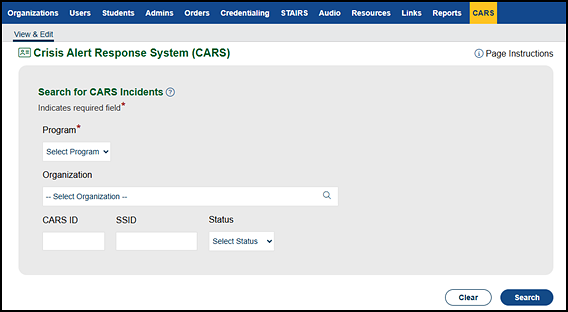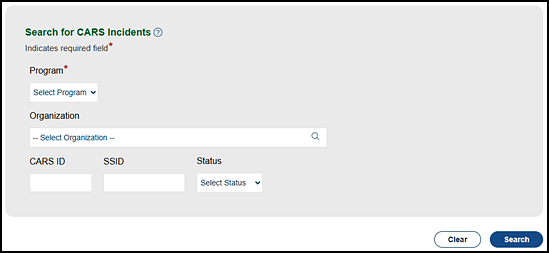Crisis Alert Response System (CARS)
Crisis Alert Response System Process
As part of the process for scoring constructed-response items, readers, hired by ETS, may come across student responses that warrant an LEA’s immediate attention. Examples include responses in which students indicate or suggest that they are experiencing or have experienced some kind of physical or emotional abuse or neglect, that they may harm themselves or others, or that they are experiencing severe distress. LEAs are notified of such instances through the CARS ID reporting process.
Upon discovery that a response requires attention, TOMS notifies the LEA CAASPP coordinators or LEA ELPAC coordinators and superintendent via email. Upon receipt, an LEA representative is required to acknowledge the CARS incident by logging on to TOMS, accessing the CARS page (figure 1), and selecting the [Acknowledge] or [Acknowledge and Archive] button.

Figure 1. [CARS] navigation tab
If the CARS incident is not acknowledged within three business hours, TOMS sends a reminder email to all of the original recipients that there has been a CARS incident logged and will continue to send reminders until the CARS incident has been acknowledged in TOMS. Note that reminders are sent on weekdays between 7 a.m. and 6 p.m. This process provides the LEA with information in a timely manner and ensures security of the CARS process.
Details of the CARS incident, including information about the student and the response or action that caused the case to be flagged, can be found by selecting the [CARS] tab from the menu bar in TOMS.
[Acknowledge] versus [Acknowledge and Archive]
When a CARS incident is acknowledged, the email notifications will cease for that incident. The case will remain open and visible on the CARS screen. This feature allows an LEA coordinator or superintendent to keep a case open until the coordinator or superintendent is satisfied that necessary actions have been completed by the LEA. LEA coordinators will receive a weekly email stating the incident number for any cases acknowledged but not archived.
Once a user has deemed a case ready to be closed, the user may archive the incident by selecting the [Archive] button. This will close the incident. Archived incidents can still be located using the search function on the CARS screen.
If the user selects the [Acknowledge and Archive] button, the email reminders for this case will cease and the incident number will not appear on the weekly open-case email. This action should be used if the appropriate persons have followed LEA procedures for this type of incident.
Working Within the CARS Screen
Once a user receives an email notification, the user will need to log on to TOMS to view the details of the incident. Users must select a role of either LEA Coordinator or Superintendent and the assessment program stated in the email subject line (either CAASPP or ELPAC).
After logging on to TOMS, select the [CARS] tab from the navigation bar. When the Crisis Alerts Response System (CARS) screen is first displayed, all incidents in the LEA for the current test administration will be displayed. The user can use the search functions to limit the incidents displayed on the screen. At the top of the table of incidents, the user can use the sort arrows in the following column headings to sort the incidents as preferred:
- CARS ID
- Grade
- Response Entry Date
- Status
On the “Search for CARS Incidents” section of the Crisis Alerts Response System (CARS) screen (figure 2), enter characters into some or all of the search fields to return a specific school, a specific CARS ID, all CARS incidents for a specific SSID for the assessment connected to the user role, or a status.

Figure 2. “Search for CARS Incidents” on the Crisis Alerts Response System (CARS) screen
Figure 2 shows the search fields and the search results. Leaving all fields blank will provide a list of all incidents.
- Select [Clear] to remove any text entered in the search fields.
- Select [Search] to begin the search.
When the results are displayed, select the [Action] magnifying glass [ ] icon to work with that specific CARS incident. The View & Edit screen will display the details of the student and a CARS Incident Summary, which provides information for these fields:
] icon to work with that specific CARS incident. The View & Edit screen will display the details of the student and a CARS Incident Summary, which provides information for these fields:
- CARS ID—Number assigned by the system to identify this incident
- LEA Name—Enrolled LEA at the time of testing
- SSID—SSID assigned to the student at the time of testing
- Grade—Enrolled grade level of student at the time of testing
- Test Name—Assessment in which the response was found
- Test Type or Domain—Domain or test portion in which the response was found
- Test ID—Information for ETS use if further information is requested
- Response Entry Date—Date and time that the student entered the response
- SSID Swap Details—Other SSID if the student was part of an SSID swap
- Status—Incident status, whether New, Acknowledged, or Archived
- Acknowledged By—Email address of the user who acknowledged the incident
- Acknowledged Date—Date and time when the incident was acknowledged
- Archived By—Email address of the user who archived the incident
- Archived Date—Date and time when the incident was archived
- Student Response—Exact words that the student entered into the constructed-response item or notepad that caused the text to be flagged
If the student has multiple incidents listed in TOMS, these incidents will be listed after the action buttons on the View & Edit screen. These incidents will be viewable only, with no action allowed. The user must open the individual incidents to take any action, which requires the user to select the [Back to Results] button to open an individual incident.
While LEA CAASPP coordinators will be able to view ELPAC alerts and LEA ELPAC coordinators will be able to view CAASPP alerts, coordinators will be able to take action only on alerts that match the role for which they are logged on.
The View & Edit screen offers three actions from which the user may select when working with this CARS incident (figure 3): acknowledge; print; or acknowledge and archive.

Figure 3. Buttons on the View & Edit screen to process the CARS incident
- Select the [Acknowledge] button to register that the incident has been opened.
- The acknowledged action will stop further reminder emails to the LEA coordinator(s) and superintendent informing them that the incident must be acknowledged.
- The incident will remain open until a user with the appropriate role archives it.
- Select the [Print] button to print a copy of the incident or save it to a PDF.
- Users should select A2 paper when printing to have all information on a single sheet.
- When the Print Dialogue box appears, users may select the [Save as PDF] option. This PDF can then be password-protected and sent to the appropriate staff who will assist the student.
- Select the [Acknowledge and Archive] button to both register that the incident has been opened and to archive it.
- The archive action will remove the incident from the weekly reminder email of open incidents.
Archiving an Acknowledged Incident
An LEA coordinator or superintendent may archive an incident that had been previously acknowledged. The user may use the search screen to locate the incident in question.
Once the required incident shows in the result table, select the [Action] magnifying glass [ ] icon to work with that specific CARS incident. The View & Edit screen will display the details of the student and a CARS Incident Summary.
] icon to work with that specific CARS incident. The View & Edit screen will display the details of the student and a CARS Incident Summary.
The CARS Incident Summary now offers only a [Print] button and an [Archive] button. By selecting the [Archive] button, the user closes the incident and archives it.
CARS LEA-Level Status Report and School-Level Status Report
The LEA coordinators for both CAASPP and ELPAC can run a CARS LEA-Level Status Report or a School-Level Status Report. These reports are found using the [Reports] navigation tab and selecting either the [LEA Reports] or [Site Reports] action tab. Both reports offer the user the option to select the Admin Year and Status.
- Admin Year—Offers the current test administration year
- Status—Offers the choice of All, Archived, Acknowledged, or New
Either report will provide an Excel file with the requested incidents based on the applied filters. All the information from the Student Information screen will appear with each incident on a separate row.

